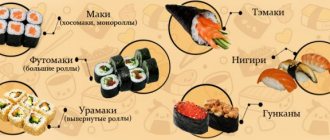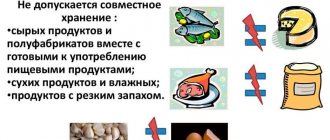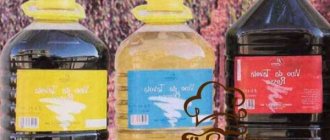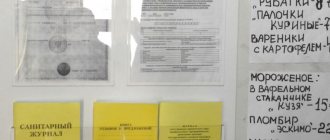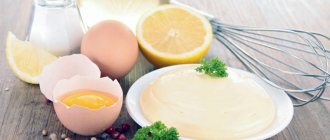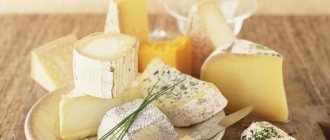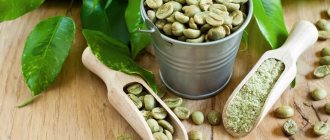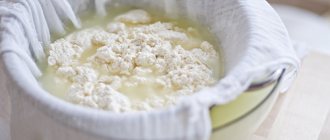Home / Complaints, courts, consumer rights / Consumer rights
Back
Published: 11/13/2018
Reading time: 24 min
0
251
In order to approve the shelf life of products, SanPiN 2.3.2.1324-03 “Hygienic requirements for shelf life and storage conditions of food products” was created. This document ensures the human right to access quality food.
- Shelf life of food: what is it?
- Food storage conditions: what they are and what they are
- Shelf life of food products
This right is also guaranteed by the following laws and regulations:
- Federal Law No. 29 of January 2, 2000 “On the quality and safety of food products.”
- SanPiN 2.3.2.1078-2001 “Hygienic requirements for the safety and nutritional value of food products.”
Classification of products according to storage conditions
To properly organize food storage in an establishment, you need to divide them into categories. This is a requirement of sanitary rules SP 2.3.6.1079-01.
Each type of product has its own storage conditions. Let's look at their features for the main categories.
| Types of products | Storage Features |
| Dry products (pasta, cereals, flour, sugar, etc.) | In the supplier's container in dry, well-ventilated places |
| Bakery products | On shelves or in special cabinets with ventilation holes in the doors Wheat and rye breads should not be stored together |
| Meat, poultry, fish, seafood | These types of products can be stored together in the same refrigerator compartment But it’s better on different shelves so that they don’t touch each other By-products, poultry and fish must be stored in supplier containers |
| Dairy and fat products | Sour cream and cottage cheese are stored in containers with lids. It is prohibited to leave spatulas or spoons in this container. Butter - in original containers, packaging or in trays, wrapped in parchment bars Ghee - in manufacturer's containers |
| Gastronomic products (these are ready-to-eat products, such as cheeses and sausages) | In supplier's packaging |
| Fruits and vegetables | In dry, dark rooms, in cool places Salted vegetables - in barrels, at a temperature not exceeding 10°C Fruits, berries and herbs - in boxes at a temperature not exceeding 12°C |
| Eggs and egg products | Eggs - in packaging, separate from other products, in cool, dry rooms Powdered eggs - in a dry room Melange - at a temperature not higher than minus 6°C |
| Coffee beans, ground coffee and tea | Separate from other products, in a dry and well-ventilated place |
| Frozen vegetables, fruits, berries | In supplier containers in low-temperature refrigerated chambers Do not defrost or refreeze |
| Frozen semi-finished products (for example, cheesecakes, donuts, dough) | Do not defrost or refreeze |
All storage conditions are indicated by the manufacturer of a specific product on its container or packaging.
Temperature conditions when storing food in preschool educational institutions
In a preschool organization, it is necessary to monitor compliance with the temperature regime in refrigeration equipment on a daily basis. Download the Temperature Monitoring Log here. This log must be kept for 1 year.
Temperature control by preschool employees includes checking:
- serviceability of thermometers (non-mercury thermometers are used for monitoring);
- compliance with the required temperature;
- the presence of a “fur coat” in the freezer;
- maintaining a refrigerator cleaning schedule (once a month or as needed).
SanPiN provides the following requirements for compliance with temperature conditions when storing food in kindergarten :
- salted vegetables are stored at a temperature no higher than plus 10 Cº;
- storage temperature for greens and fruits – no higher than plus 12 Cº;
- fermented milk and other perishable products must be kept before serving for no more than 1 hour at room temperature in a closed consumer package, so that their temperature becomes plus 15 +/- 2 Cº;
- if the vegetables for the salad were boiled in advance, then they can be stored at a temperature of plus 4 +/- 2Cº in a marked container (boiled vegetables) - no more than 6 hours;
- Undressed salads should be stored for no more than 2 hours, and seasoned ones - no more than half an hour, storage temperature - plus 4 +/- 2 Cº;
- Cereals, potatoes and root vegetables, cabbage are stored at a temperature of no more than plus 10 Cº.
Conditions for storing products in a warehouse
All products in the establishment must meet food safety requirements.
To do this you must:
1. Check upon receipt from the supplier
that the peculiarities of storage and transportation of each type of product and their careful unloading were observed.
2. Observe proper storage conditions
— continuously from the moment of acceptance of products to the sale of finished products. Organize storage, taking into account the principle of “commodity proximity” and the requirements for storage temperature, humidity and lighting.
3. Systematically control
the condition of the products, their containers or packaging, storage conditions, sanitary and hygienic condition of the warehouse.
4. Conduct training and create a checklist
for employees on food storage rules.
5. Apply markings
for goods and finished products.
6. Don't allow
contact of products with non-food products, if this may lead to contamination of food products.
7. Don't allow
to ensure that there are no strangers in the warehouse and production workshop.
All storage equipment must be specialized to withstand constant sanitization and be quickly repaired in the event of breakdown. Such equipment differs from household appliances in its design, volume, body materials and components. For example, professional refrigerators do not have glass shelves.
An example of food storage in an establishment
Disposal of expired products
The ban on the sale of food products after the expiration period is outlined in Article 472 of the Civil Code of the Russian Federation and No. 2300-FZ “On the Protection of Consumer Rights”.
Reference. The term “disposal” implies that an expired product can be used in the future, but no longer for its intended purpose. And as animal feed, processing into jam or vinegar, etc.
The write-off of food products with an expired shelf life takes place in several stages:
- The owner of the product contacts Rospotrebnadzor to conduct an examination of the product.
- After inspection, the authorized body issues a conclusion that the product can be disposed of.
There are 3 methods for processing recycled materials:- production of animal feed;
production of jams, vinegars;
- biological processing (composting).
- Until disposal, all expired products must be stored in strictly designated areas and in accordance with sanitary requirements.
- Disposal is carried out by specialized companies licensed by Rospotrebnadzor to carry out activities for the disposal of a specific type of waste.
- The owner of the product is obliged to notify the authority that issued the permit for disposal of the product with an expiring shelf life within 3 days that the product has been transferred to the appropriate company for further use.
Commodity neighborhood rules
Product neighborhood rules establish which products can and cannot be stored together. You must follow them to ensure the safety, spoilage and contamination of different categories of food products by microorganisms.
Cannot be stored together:
- raw products, semi-finished products and finished products;
- frozen and chilled foods;
- dry and wet foods (when stored together, dry foods will absorb moisture and spoil);
- products that give off odor (spices, herring, etc.) and products that absorb it (butter, cheese, eggs, tea, salt, sugar, etc.).
Incompatible foods should be separated into different refrigerators or airtight containers.
How can you lower the storage temperature of vegetables and fruits?
When storing fruit and vegetable crops in a refrigeration unit, you can affect the existing temperature. To do this, increase air circulation and the products will be able to cool with greater force due to blowing.
This method is called forced air cooling and is used by most companies. To use it in production, refrigeration units need to be modernized. If this is not a profitable investment, then portable devices for forced air cooling are also used. But it is imperative to take into account the location of compatible products and, if necessary, make castling.
To keep vegetables and fruits fresh and not wither, you need to preserve their own moisture. For this purpose, there is another method of storing fruit and vegetable crops - hydrocooling. The essence of this method is that heat exchange occurs faster than with the above method.
Proper storage of vegetables and fruits is the key to your health.
Requirements for temperature, air humidity and lighting
You must ensure that each type of food is stored within its specified temperature, humidity and lighting parameters. This is a requirement of SanPiN 2.3.2.1324-03.
The same SanPiN provides for the storage temperature and expiration dates of perishable products.
Below we give general temperature and humidity conditions for storing food products. But regarding the storage conditions of specific products, you need to rely on information from the manufacturer.
Requirements for food storage temperature
| Products | Storage temperature | Temperature group |
| Meat, fish, oil, fats | -10…-12°С | Frozen |
| Meat fish | -18…-20°С | |
| Meat, fish, fruits, vegetables | -23…-30°С | |
| Boiled and smoked sausages, margarine, fruits, vegetables | -2…-5°С | Hypothermic |
| Raw smoked sausages, fats, fish | -7…-10°С | |
| Fruits, berries, vegetables, eggs | -1…+1°С | Chilled |
| Dairy products, cakes, pastries | 0…+6°С | |
| Soft drinks, alcohol (except vodka, beer) | +10…+12°С | Moderate |
| Bakery products, flour, cereals, sugar, alcohol, water | -30…+30°С | Wide range |
| Confectionery, wine, jam, marmalade | 0…+20°С | Wide range of positive temperatures |
Humidity requirements for food storage
| Products | Humidity | Humidity group |
| Cereals, flour, salt, sugar, dried fruits, spices | no higher than 65% | Dry |
| Coffee, tea, confectionery | no higher than 75% | Moderate |
| Dairy products, onions, garlic, meat, fish, wine | no higher than 85% | Wet |
| Vegetables, frozen fruits | not higher than 95% | High humidity |
It is impossible to provide different levels of humidity in one room. Therefore, when designing storage areas, separate zones are distinguished - a dry warehouse and a vegetable warehouse. They have different levels of humidity and other microclimate parameters. There is also the concept of “daily storage warehouse”. Products are moved there for one or two work shifts. The microclimate indicators there are general, but food does not spoil within a day.
Legislative framework of the Russian Federation
not valid Edition from 15.04.2003
detailed information
| Name of document | DECREE of the Chief State Sanitary Doctor of the Russian Federation dated November 14, 2001 N 36 (as amended on April 15, 2003) “ON THE INTRODUCTION OF SANITARY RULES” (together with “HYGIENIC REQUIREMENTS FOR THE SAFETY AND NUTRITIONAL VALUE OF FOOD PRODUCTS. SANITARY - EPIDEMIOLOGIST ICE RULES AND REGULATIONS SanPiN 2.3 .2.1078-01") (Appendix 1) |
| Document type | decree, rules |
| Receiving authority | Chief State Sanitary Doctor of the Russian Federation, Ministry of Health of the Russian Federation |
| Document Number | 36 |
| Acceptance date | 01.09.2002 |
| Revision date | 15.04.2003 |
| Registration number in the Ministry of Justice | 3326 |
| Date of registration with the Ministry of Justice | 22.03.2002 |
| Status | It does not work |
| Publication |
|
| Navigator | Notes |
DECREE of the Chief State Sanitary Doctor of the Russian Federation dated November 14, 2001 N 36 (as amended on April 15, 2003) “ON THE INTRODUCTION OF SANITARY RULES” (together with “HYGIENIC REQUIREMENTS FOR THE SAFETY AND NUTRITIONAL VALUE OF FOOD PRODUCTS. SANITARY - EPIDEMIOLOGIST ICE RULES AND REGULATIONS SanPiN 2.3 .2.1078-01") (Appendix 1)
1.3. Fish, non-fish species and products made from them
| Index, product group | Indicators | Permissible levels, mg/kg, no more | Note | |||
| 1 | 2 | 3 | 4 | |||
| 1.3.1. Live fish, raw fish, chilled, frozen, minced meat, fillet, meat of marine mammals | Toxic elements: | |||||
| lead | 1,0 | |||||
| 2,0 | tuna, swordfish, beluga | |||||
| arsenic | 1,0 | freshwater | ||||
| 5,0 | maritime | |||||
| cadmium | 0,2 | |||||
| mercury | 0,3 | freshwater non-predatory | ||||
| 0,6 | freshwater carnivore | |||||
| 0,5 | maritime | |||||
| 1,0 | tuna, swordfish, beluga | |||||
| Histamine | 100,0 | tuna, mackerel, salmon, herring | ||||
| Nitrosamines: sum of NDMA and NDEA | 0,003 | |||||
| Pesticides <*>: Hexachlorocyclohexane (alpha, alpha -, | 0,2 | seafood, meat of sea animals | ||||
| beta -, gamma - isomers) | 0,03 | Freshwater | ||||
| DDT and its meta | 0,2 | Marine | ||||
| sore | 0,3 | freshwater | ||||
| 2,0 | sturgeon, salmon, fatty herring | |||||
| 0,2 | sea animal meat | |||||
| 2,4-D acid, its salts and esters | not allowed | freshwater | ||||
| Polychlorinated biphenyls | 2,0 | |||||
| Radionuclides: cesium-137 | 130 | Bq/kg | ||||
| strontium-90 | 100 | Same | ||||
| (as amended by the Resolution of the Chief State Sanitary Doctor of the Russian Federation dated April 15, 2003 N 41) | ||||||
| Microbiological indicators: | ||||||
| Index, product group | KMAFAnM, CFU/g, no more | Weight of product (g) in which it is not allowed | Note | |||
| Coliforms (coliforms) | S. aureus | Pathogenic, including salmonella and L. monocytogenes | ||||
| 1.3.1.1. Raw fish and live fish | 5 x 1E4 | 0,01 | 0,01 | 25 | V. parahaemolyticus - no more than 100 CFU/g, for marine fish | |
| (as amended by the Resolution of the Chief State Sanitary Doctor of the Russian Federation dated April 15, 2003 N 41) | ||||||
| 1.3.1.2. Chilled, frozen fish | 1 x 1E5 | 0,001 | 0,01 | 25 | Same | |
| 1.3.1.3. Chilled and frozen fish products: | ||||||
| — fish fillet, specially cut fish | 1 x 1E5 | 0,001 | 0,01 | 25 | Same; sulfite-reducing clostridia in 0.01 g are not allowed in vacuum-packed products | |
| — minced fish food, molded minced products, including those with a flour component | 1 x 1E5 | 0,001 | 0,01 | 25 | Same | |
| - minced meat of special condition | 5 x 1E4 | 0,01 | 0,1 | 25 <*> | sulfite-reducing clostridia in 0.1 g are not allowed in products packaged under vacuum <*> only salmonella | |
| Index, product group | Indicators | Permissible levels, mg/kg, no more | Note | |||
| 1.3.2. Canned food and preserved fish | Toxic elements: | |||||
| lead, | According to clause 1.3.1 | |||||
| arsenic, | ||||||
| cadmium, | ||||||
| mercury, | ||||||
| tin | 200 | in prefabricated tin containers | ||||
| chromium | 0,5 | in chrome plated container | ||||
| benz(a)pyrene | 0,001 <*> | <*> for smoked products | ||||
| Histamine, nitrosamines, pesticides, polychlorinated biphenyls and radionuclides | according to clause 1.3.1 | |||||
| (as amended by the Resolution of the Chief State Sanitary Doctor of the Russian Federation dated April 15, 2003 N 41) | ||||||
| Microbiological indicators: | ||||||
| Index, product group | KMAFAnM, CFU/g, no more | Weight of product (g) in which it is not allowed | Note | |||
| Coliforms (coliforms) | S. aureus | Sulfite-reducing clostridia | Pathogenic, including salmonella and L. monocytogenes | |||
| 1 | 2 | 3 | 4 | 5 | 6 | 7 |
| 1.3.2.1. Spicy and specially salted preserves from uncut and cut fish | 1 x 1E5 | 0,01 | 0,01 | 25 | mold no more than 10 CFU/g, yeast - no more than 100 CFU/g | |
| 1.3.2.2. Lightly salted preserved fish, spicy and specially salted: | mold no more than 10 CFU/g, yeast - no more than 100 CFU/g | |||||
| - uncut | 1 x 1E5 | 0,01 | 1,0 | 0,01 | 25 | |
| - butchered | 5 x 1E4 | 0,01 | 1,0 | 0,01 | 25 | Same |
| 1.3.2.3. Preserves from cut fish with the addition of vegetable oils, fillings, sauces, with and without side dishes (including salmon fish) | 2 x 1E5 | 0,01 | 1,0 | 0,01 | 25 | Same |
| (as amended by the Resolution of the Chief State Sanitary Doctor of the Russian Federation dated April 15, 2003 N 41) | ||||||
| 1.3.2.4. Preserved pasta: | ||||||
| - fish pastes | 5 x 1E5 | 0,01 | 0,1 | 0,01 | 25 | Same |
| - from protein paste | 1 x 1E5 | 0,1 | 0,1 | 0,1 | 25 | Same |
| 1.3.2.5. Preserves from thermally processed fish | 5 x 1E4 | 1,0 | 1,0 | 1,0 | 25 | |
| 1.3.2.6. Canned fish in glass, aluminum and tin containers | Must meet the requirements of industrial sterility for canned food of group “A” in accordance with Appendix 8 to these sanitary rules | |||||
| 1.3.2.7. Semi-canned pasteurized fish in glass containers | Must meet the requirements of industrial sterility for canned food of group “D” in accordance with Appendix 8 to these sanitary rules | |||||
| Index, product group | Indicators | Permissible levels, mg/kg, no more | Note | |||
| 1 | 2 | 3 | 4 | |||
| 1.3.3. Dried, dried, smoked, salted, spicy, marinated fish, fish cooking and other fish products, ready to eat | Toxic elements, histamine and polychlorinated biphenyls | according to clause 1.3.1. | in terms of the initial product, taking into account the content of dry substances in it and the final products | |||
| - smoked, salted, pickled and other fish products | Nitrosamines: sum of NDMA and NDEA | 0,003 | ||||
| Radionuclides: | according to clause 1.3.1 | |||||
| - fish | cesium-137 | 260 | Bq/kg | |||
| dried, dried | strontium-90 | 200 | Same | |||
| Pesticides <*>: hexachlorocyclohexane (alpha -, beta -, gamma - isomers) | 0,2 | |||||
| DDT and its metabolites | 0,4 | balyk products, herring fatty smoked fish | ||||
| 2,0 | ||||||
| Benz(a)pyrene | 0,001 | |||||
| (as amended by the Resolution of the Chief State Sanitary Doctor of the Russian Federation dated April 15, 2003 N 41) | ||||||
| Microbiological indicators: | ||||||
| Index, product group | KMAFA nM, CFU/g, no more | Weight of product (g) in which it is not allowed | Note | |||
| Coliforms (coliforms) | S. aureus | Sulfite-reducing clostridia | Pathogenic, including salmonella and L. monocytogenes | |||
| 1 | 2 | 3 | 4 | 5 | 6 | 7 |
| 1.3.3.1. Hot smoked fish products, incl. frozen | 1 x 1E4 | 1,0 | 1,0 | 0,1 <*> | 25 | <*> vacuum packed |
| 1.3.3.2. Cold smoked fish products, incl. frozen: - uncut | 1 x 1E4 | 0,1 | 1,0 | 0,1 <*> | 25 | the same <*> V. parahaemoluticus - no more than 10 CFU/g, for marine fish |
| - cut, including slicing (piece, serving) | 3 x 1E4 | 0,1 | 1,0 | 0,1 <*> | 25 | the same <*> V. parahaemoluticus - no more than 10 CFU/g, for marine fish |
| — cold smoked balyk products, incl. in-cut | 7.5 x 1E4 | 0,1 | 1,0 | 0,1 <*> | 25 | vacuum packed <*> |
| — assorted fish, sausages, minced balyk, spiced products | 1 x 1E5 | 0,01 | 1,0 | 0,1 <*> | 25 | the same <*> |
| (as amended by the Resolution of the Chief State Sanitary Doctor of the Russian Federation dated April 15, 2003 N 41) | ||||||
| 1.3.3.3. Cut-up, smoked, lightly salted fish, including fillets | 5 x 1E4 | 0,1 | 1,0 | 0,1 <*> | 25 | V. parahaemoluticus - no more than 10 CFU/g, for sea fish <*>, vacuum packed |
| (as amended by the Resolution of the Chief State Sanitary Doctor of the Russian Federation dated April 15, 2003 N 41) | ||||||
| 1.3.3.4. Salted, spicy, marinated fish, incl. frozen | ||||||
| - uncut | 1 x 1E5 | 0,1 | 0,1 <*> | 25 | <*> vacuum packed; | |
| - cut salted and lightly salted, incl. salmon without preservatives, fillet, sliced; with fillings, spices, side dishes, vegetable oil | 1 x 1E5 | 0,01 | 0,1 | 0,1 <*> | 25 | <*> vacuum packed |
| (as amended by the Resolution of the Chief State Sanitary Doctor of the Russian Federation dated April 15, 2003 N 41) | ||||||
| 1.3.3.5. Dried fish | 5 x 1E4 | 0,1 | 1,0 | 25 <*> | <*> - only salmonella mold - no more than 50 CFU/g, yeast - no more than 100 CFU/g | |
| (as amended by the Resolution of the Chief State Sanitary Doctor of the Russian Federation dated April 15, 2003 N 41) | ||||||
| 1.3.3.6. Hanging fish | 5 x 1E4 | 0,1 | 1,0 <*> | 25 <**> | <*> vacuum packed; <**> salmonella only; molds and yeasts no more than 100 CFU/g | |
| 1.3.3.7. Dried fish | 5 x 1E4 | 0,1 | 0,01 <*> | 25 <**> | <*> the same; <**> the same | |
| (as amended by the Resolution of the Chief State Sanitary Doctor of the Russian Federation dated April 15, 2003 N 41) | ||||||
| 1.3.3.8. Dry soups with fish that require cooking | 5 x 1E5 | 0,001 | 25 <*> | <*> salmonella only; molds and yeasts no more than 100 CFU/g | ||
| 1.3.3.9. Heat-treated culinary products: | ||||||
| - fish and minced products, pastes, pates, baked, fried, boiled, in fillings, etc.; with a flour component (pies, dumplings, etc.); incl. frozen; | 1 x 1E4 | 1,0 | 1,0 | 1,0 <*> | 25 <**> | <*> vacuum packed; <**> salmonella only; molds and yeasts no more than 100 CFU/g |
| - multi-component products - solyanka, pilaf, snacks, stewed seafood with vegetables, incl. frozen; | 5 x 1E4 | 0,01 | 1,0 | 1,0 <*> | 25 <**> | <*> vacuum packed; <**> salmonella only; |
| - gelled products: jelly, jellied fish, etc. | 5 x 1E4 | 0,1 | 1,0 | 25 <*> | <*> salmonella only | |
| 1.3.3.10. Culinary products without heat treatment: | ||||||
| — fish and seafood salads without dressing; | 1 x 1E4 | 1,0 | 1,0 | 25 | Proteus in 0.1 g are not allowed | |
| - chopped salted fish; pates, pastes; | 2 x 1E5 | 0,01 | 0,1 | 25 | Same | |
| — herring oil, caviar oil, krill oil, etc. | 2 x 1E5 | 0,001 | 0,1 | 25 | Same | |
| 1.3.3.11. Boiled frozen products: | ||||||
| — quick-frozen ready-made lunch and snack fish dishes, pancakes with fish, fish filling, incl. vacuum packed | 2 x 1E4 | 0,1 | 0,1 | 0,1 <*> | 25 | Enteroco - ccus - 1 x 1E3 CFU/g, no more (in products from portioned pieces) <*> vacuum packed |
| — structured products (“crab sticks”, etc.) | 1 x 1E3 | 1,0 | 1,0 | 1,0 | 25 | Enteroco - ccus - 2 x 1E3 CFU/g, no more (in minced meat) |
| 1.3.3.12. Mayonnaise based on fish broths | 0,01 | 25 <*> | <*> salmonella only; mold no more than 10 CFU/g, yeast no more than 100 CFU/g | |||
| Index, product group | Indicators | Permissible levels, mg/kg, no more | Note | |||||
| 1 | 2 | 3 | 4 | |||||
| 1.3.4. Fish caviar and milt and products from them; caviar analogues | Toxic elements: | |||||||
| lead | 1,0 | |||||||
| arsenic | 1,0 | |||||||
| cadmium | 1,0 | |||||||
| mercury | 0,2 | |||||||
| Pesticides <*>: Hexachlorocyclohexane (alpha -, beta -, gamma - isomers) | 0,2 | |||||||
| DDT and its metabolites | 2,0 | |||||||
| Polychlorinated biphenyls, radionuclides | according to clause 1.3.1 | |||||||
| Microbiological indicators: | ||||||||
| Index, product group | KMAFAnM, CFU/g, no more | Weight of product (g) in which it is not allowed | Mold, CFU/g, no more | Yeast, CFU/g, no more | Note | |||
| Coliforms (coliforms) | S. aureus | Sulfite reducing clostridia | Pathogenic, incl. salmonella | |||||
| 1 | 2 | 3 | 4 | 5 | 6 | 7 | 8 | 9 |
| 1.3.4.1. Milk and caviar, chilled and frozen | 5 x 1E4 | 0,001 | 0,01 | 25 | L. monocytogenes in 25 g are not allowed; V. parahaemolyticus - no more than 100 CFU/g, for marine fish | |||
| 1.3.4.2. Salted milk | 1 x 1E5 | 0,1 | 0,1 | 25 | L. monocytogenes in 25 g are not allowed | |||
| 1.3.4.3. Culinary caviar products: | ||||||||
| - with heat treatment | 1 x 1E4 | 1,0 | 1,0 | 25 | ||||
| — multi-component dishes without heat treatment after mixing | 2 x 1E5 | 0,1 | 0,1 | 25 | L. monocytogenes in 25 g are not allowed; Proteus in 0.1 g are not allowed | |||
| 1.3.4.4. Sturgeon caviar: | ||||||||
| - granular canned, pressed | 1 x 1E4 | 1,0 | 1,0 | 1,0 | 25 | 50 | 50 | |
| — granular pasteurized | 1 x 1E3 | 1,0 | 1,0 | 1,0 | 25 | 0,1 <*> | 0,1 <*> | <*> mass (g), in which are not allowed |
| - lightly salted poultry, salted | 5 x 1E4 | 1,0 | 1,0 | 1,0 | 25 | 50 | 100 | |
| 1.3.4.5. Salted granular salmon caviar: | 1 x 1E5 | 1,0 | 1,0 | 1,0 | 25 | 50 | 300 | |
| - can, barrel | ||||||||
| - from frozen eggs | 5 x 1E4 | 1,0 | 1,0 | 1,0 | 25 | 50 | 200 | |
| 1.3.4.6. Caviar of other fish species: | ||||||||
| — punchy salted; lightly salted poached, smoked, dried | 1 x 1E5 | 0,1 | 1,0 | 1,0 | 25 | 50 | 300 | <*> mass (g), in which are not allowed |
| — pasteurized | 5 x 1E3 | 1,0 | 1,0 | 1,0 | 25 | 0,1 <*> | 0,1 <*> | |
| 1.3.4.7. Caviar analogues, incl. protein | 1 x 1E4 | 0,1 | 1,0 | 0,1 | 25 | 50 | 50 | |
| Index, product group | Indicators | Permissible levels, mg/kg, no more | Note |
| 1 | 2 | 3 | 4 |
| 1.3.5. Fish liver and products made from it | Toxic elements: | ||
| lead | 1,0 | ||
| cadmium | 0,7 | ||
| mercury | 0,5 | ||
| tin | 200,0 | for canned food in prefabricated tin containers | |
| chromium | 0,5 | for canned food in chrome containers | |
| Pesticides <*>: Hexachlorocyclohexane (alpha -, beta -, gamma - isomers) | 1,0 | ||
| DDT and its metabolites | 3,0 | ||
| Polychlorinated biphenyls | 5,0 | ||
| Radionuclides | according to clause 1.3.1 | ||
| Microbiological indicators: | |||
| 1.3.5.1. Canned fish liver | Must meet the requirements of industrial sterility for canned food of group “A” in accordance with Appendix 8 to these sanitary rules | ||
| 1.3.5.2. Liver, frozen fish heads | Microbiological indicators: | ||
| QMAFAnM Coliforms (coliforms) | 1 x 1E5 0.001 | CFU/g, no more, mass of product (g), in which are not allowed | |
| S. aureus | 0,01 | Same | |
| V. parahaemolyticus - | 100 | CFU/g, no more, for sea fish | |
| Pathogenic microorganisms, incl. salmonella and L. monocytogenes | 25 | Same | |
| Index, product group | Indicators | Permissible levels, mg/kg, no more | Note | |||
| 1.3.6. Fish oil | See section “Oil raw materials and fatty products”, paragraph 1.7.8 | |||||
| 1.3.7. Non-fish species (molluscs, crustaceans and other invertebrates; algae and sea grasses) and their processed products, amphibians, reptiles: | ||||||
| - molluscs, crustaceans and other invertebrates, amphibians, reptiles | Toxic elements: | |||||
| lead | 10,0 | |||||
| arsenic | 5,0 | |||||
| cadmium | 2,0 | |||||
| mercury | 0,2 | |||||
| Radionuclides: | ||||||
| cesium-137 | 200 | Bq/kg | ||||
| strontium-90 | 100 | Bq/kg | ||||
| - algae and sea grasses | Toxic elements: | |||||
| lead | 0,5 | |||||
| arsenic | 5,0 | |||||
| cadmium | 1,0 | |||||
| mercury | 0,1 | |||||
| Radionuclides: | ||||||
| cesium-137 | 200 | Bq/kg | ||||
| strontium-90 | 100 | Bq/kg | ||||
| (as amended by the Resolution of the Chief State Sanitary Doctor of the Russian Federation dated April 15, 2003 N 41) | ||||||
| Microbiological indicators: | ||||||
| Index, product group | KMA-FAnM, CFU/g, no more | Coliforms (coliforms) | S. aureus | sulfite-reducing clostridia | pathogenic, incl. salmonella | Note |
| 1.3.7.1. Non-fish species - crustaceans and other invertebrates (cephalopods and gastropods, echinoderms, etc.): | ||||||
| - alive | 5 x 1E4 | 0,01 | 0,01 | 25 | V. parahaemoluticus - no more than 100 CFU/g, for marine | |
| - chilled, frozen | 1 x 1E5 | 0,001 | 0,01 | 25 | Same | |
| Non-fish species - bivalve mollusks (mussels, oysters, scallops, etc.): | ||||||
| - alive | 5 x 1E3 | 1,0 | 0,1 | 0,1 | 25 | E. coli in 1 g is not allowed, Enterococcus - not allowed in 0.1 g V. parahaemoluticus - not allowed in 25 g, for marine |
| - chilled, frozen | 5 x 1E4 | 0,1 | 0,1 | 25 | V. parahaemoluticus - no more than 100 CFU/g, for marine | |
| (as amended by the Resolution of the Chief State Sanitary Doctor of the Russian Federation dated April 15, 2003 N 41) | ||||||
| 1.3.7.2. Preserves from non-fish species with the addition of vegetable oils, fillings, sauces with and without garnish | 2 x 1E5 | 0,01 | 1,0 | 0,01 | 25 <*> | <*> salmonella only; mold no more than 10 CFU/g, yeast - no more than 100 CFU/g |
| 1.3.7.3. Preserved meat of bivalve mollusks | 5 x 1E4 | 0,1 | 0,1 | 25 <*> | <*> salmonella only; mold no more than 10 CFU/g, yeast - no more than 100 CFU/g | |
| 1.3.7.4. Canned food from non-fish species | Must meet the requirements of industrial sterility for canned food of group “A” in accordance with Appendix 8 to these sanitary rules | |||||
| 1.3.7.5. Dried and dried marine invertebrate products | 2 x 1E4 | 1,0 | 0,1 | 25 <*> | <*> salmonella only; molds and yeasts no more than 100 CFU/g | |
| 1.3.7.6. Boiled - frozen products from non-fish species: | ||||||
| - crustaceans | 2 x 1E4 | 0,1 | 0,1 | 1,0 <*> | 25 | <*> vacuum packed; Enterococcus, CFU/g, no more than: 1 x 1E3 - in products from portioned pieces, 2 x 1E3 - in minced meat |
| — shellfish meat, dishes made from bivalve mollusc meat | 2 x 1E4 | 0,1 | 1,0 | 1,0 <*> | 25 | <*> vacuum packed; Enterococcus, CFU/g, no more than: 1 x 1E3 - in products from portioned pieces, 2 x 1E3 - in minced meat |
| - from shrimp, crab, krill meat | 2 x 1E4 | 0,1 | 1,0 | 1,0 <*> | 25 | <*> the same; Enterococcus, CFU/g, no more than: 1 x 1E3 - in products from portioned pieces, 2 x 1E3 - in minced meat |
| 1.3.7.7. Dried and protein non-fish seafood: | ||||||
| - dry mussel broth, bouillon cubes and pastes, isolated protein | 5 x 1E4 | 0,1 | 0,01 | 25 <*> | <*> salmonella only | |
| — mussel hydrolyzate (MIGI-K) | 5 x 1E3 | 1,0 | 1,0 | 25 <*> | <*> the same | |
| — protein-carbohydrate concentrate from mussels | 1,0 | 1,0 | 1,0 | 25 <*> | <*> the same | |
| 1.3.7.8. Algae, sea grasses and products made from them: | ||||||
| - seaweed and sea grass - raw, incl. frozen | 5 x 1E4 | 0,1 | 25 <*> | <*> the same | ||
| - dried seaweed and herbs | 5 x 1E4 | 1,0 | 25 <*> | <*> salmonella only; mold no more than 100 KOH/g | ||
| - seaweed jams | 5 x 1E3 | 1,0 | 25 <*> | <*> salmonella only | ||
| (as amended by the Resolution of the Chief State Sanitary Doctor of the Russian Federation dated April 15, 2003 N 41) | ||||||
<*> It is necessary to control the residual quantities of those pesticides that were used in the production of food raw materials (see paragraphs 3.12, 3.13).
Accounting for products in warehouse
To keep track of expiration dates and storage conditions, you need to label the products in your warehouse.
These are the requirements of the technical regulation of the Customs Union 022/2011 “Food products regarding their labeling”.
Please note the following rules:
- Until the container and packaging is opened, the manufacturer's marking is valid.
- When products arrive, you need to make your own labeling - indicate the date of receipt at the warehouse (even if the products arrived with the correct product label, which is not always the case).
- If large volumes arrived and you packaged them in smaller containers (for ease of storage and handling of the product), then for each container or package you must duplicate the full supplier labeling and indicate the date of repacking.
- You can only store it in the supplier's packaging in the warehouse. As soon as the products are sent to work, you must repack them and re-label them.
- You must label prepared meals if you sell them through takeout or delivery.
Let's consider what the labeling should contain depending on the type of food product.
| What we label | What should the label contain? |
| Raw materials, blanks and semi-finished products |
|
| Products that we transfer from factory packaging to our own containers Important! Retain the product label from the supplier until the end of the product's use. |
|
| Prepared meals that you sell for takeout or delivery |
|
How to apply markings
There are no legal requirements for how to apply the markings. For example, you can apply hand-signed labels or barcode markings.
The marking must be affixed to the container or packaging of the product, if there is no packaging - to the product itself
(for example, for each pineapple or orange).
If you mark using a barcode, you can read the encrypted information using a scanner.
Markings on overpacked products
| Using the Qiuck Resto , you can organize the labeling of products in the warehouse: assign a barcode to each product, connect a scanner to the system (you can purchase it from us) and receive goods with one click. |
Fines and seizure of products for incorrect labeling
You can’t just stick a label with the date and time of manufacture. This has been done in public catering for more than ten years, guided by the sanitary rules of SP 2.3.6.1079-01. Currently, such labeling is considered insufficient.
There are fines for violating labeling rules
under articles 14.7 and 14.8 of the Administrative Code. Maximum fines: for individual entrepreneurs - from 12,000 to 20,000 rubles, for LLCs - from 100,000 to 500,000 rubles.
Mislabeled products may be confiscated and discarded.
Procedure for determining the expiration date
The procedure for determining the storage duration consists of the following operations:
- Applying for testing.
- Providing a package of documents.
- Signing a contract for the provision of services.
- Providing product samples.
- Directly carrying out all necessary tests.
- Formalization of results and provision of them to the customer.
By contacting us, you can confirm the shelf life of your product in accordance with all regulatory requirements. All applicants receive a free consultation, during which you will receive answers to all your questions. All services are offered at reasonable prices and complete confidentiality is guaranteed regarding information provided by the client and obtained during testing. We are waiting for your applications!
Who sets expiration dates and storage conditions for food products?
Shelf life of products is established on the basis of actual studies or according to GOST / TU. If products are manufactured in strict accordance with GOST standards and the manufacturer indicates on the label the expiration date specified in the regulatory documentation, there is no need to confirm this fact. The manufacturer can independently declare that the goods it produces have expiration dates different from those specified in the technical documentation. To officially confirm this fact, you need to obtain official confirmation. This confirmation is the test report. It is drawn up based on the results of testing samples in laboratory conditions. Only upon receipt of a test report, the manufacturer, without violating the TR standards, can provide information about extended or reduced shelf life of goods.
How to confirm expiration dates of food products?
To confirm the shelf life of products, laboratory tests must be carried out. They must be organized in accordance with the MUK, SanPin and other regulations. The essence of the assessment is to determine the actual period during which the product can retain the consumer properties declared by the manufacturer. After completion of the tests, a protocol is drawn up. This is an official document in which information about the results obtained is entered. It contains information about: • names of goods; • name of the manufacturer; • the methodology that was used to conduct the research; • date of organization of the assessment; • research results – official conclusions.
Who sets the warranty period for a product?
Initially, warranty periods are established by law - Articles 471, 472, 473 of Chapter 30 of the Civil Code of the Russian Federation. However, the manufacturer may increase the warranty period at its discretion.
How is the shelf life of a product calculated?
It’s more correct to say that expiration dates are not considered, but set. If we are talking directly about how to correctly count the period, then it starts from the moment you start using / opening the package. If it is necessary to establish the shelf life of a product, then research is carried out - samples are taken and placed in specified storage conditions that exactly comply with regulatory requirements - temperature, humidity, etc. After the specified shelf life ends, the samples are examined for several indicators that may indicate the possibility of consuming the product. These indicators include: • organoleptics; • microbiological and sanitary indicators; • physical properties. A conclusion about a reduced or extended shelf life is made only if all the determined indicators meet the standards.
Disposal of damaged goods
Products that have expired or have changed in their consumer qualities are considered spoiled (for example, they have become rotten, moldy, withered, dried out, etc.).
Sale of spoiled products is not allowed. You must write off such products and dispose of them. This is established by the technical regulations of the Customs Union.
Disposal of spoiled products is carried out by specialized organizations that remove solid household and food waste. Without such an agreement, no establishment or catering outlet can operate.
You can write off damaged products using an act using old accounting forms or use document forms from automation systems.
Monitoring compliance with savings rules
Control over the process of compliance with storage conditions and periods is carried out by a merchandiser or, depending on the availability of employees at the point of sale, by a seller/administrator/pharmacist/storekeeper, etc.
The frequency of such control is determined for each group of goods individually. For example:
- milk and dairy products – once every two to three days;
- cereals – once every two weeks;
- cosmetic and household goods - once a month, etc.
Ways to control expiration dates:
- Manual accounting. This is carried out with the help of a responsible person at the enterprise, who keeps several accounting logs to record the necessary parameters.
- Accounting using the Excel spreadsheet editor. It is convenient for making corrections and will allow you to interpret information correctly without confusing handwriting, as in the manual version.
- Automated accounting using specialized programs. They are the best tool that allows you to control the status of expiration dates, since all actions are carried out by the program, and the person in charge only enters information.
The system itself is able to notify about goods that are close to the end of the sale date, which makes it possible to eliminate delays in products and loss of funds.
Product accounting in the automation system
Enter product data into the automation system immediately after receiving it from the supplier.
This way you will see reliable information on stock balances in the system.
But if you did not manage to deposit the products immediately, you can post them to Quick Resto retroactively.
After this, the system will automatically recalculate all sales and stock balances and display the current values for the required date.
Sign up for a free consultation. We'll tell you how to automate product accounting in a warehouse:
How to capitalize products and reflect their movements
Documents for warehouse accounting are located in the “Warehouse” section.
Directly at the cash register or in the back office, you can receive products and create requests for their movement to warehouses and sales locations.
To post products, you need to create a “Receipt Invoice” document. We talked in more detail about the acceptance of goods in another material; a link to it will be at the end of this article.
And based on the application, the employee responsible for the warehouse does:
- act of preparation, when it is necessary to write off the ingredients for the production of a semi-finished product and then enter the semi-finished product into the warehouse;
- act on internal movement, when it is necessary to move products to another warehouse or ready-made dishes from the production workshop to the places of their sale.
Also in the warehouse documents there is a write-off statement for products that are subject to disposal.
All documents are stored on Quick Resto servers indefinitely and can be restored if you delete them from the system.
Alerts when product runs out
In Quick Resto, you can set up alerts to be sent to your email when products are low.
This is done like this:
1. Set up the newsletter:
1 Enterprise → Settings → 2 Notifications → 3 Send information on warehouse balances (check the box) → 4 E-mail (add your email) → 5 Mailing time (choose one that is convenient for you).
2. Set a balance limit for each product:
1 Nomenclature → 2 Ingredients → 3 Select the desired ingredient → 4 “Basic” tab → 5 Remaining limit (set the value you need).
Reports on stock balances
Report 1: number of products separately for each warehouse
What we are watching:
product balances as of a certain date separately for each warehouse.
How the report helps:
Monitor that there is no excess stock of products in the warehouse. After looking at the report, you can quickly move excess items to another warehouse or use them faster when cooking.
How to find the report:
1 Enterprise → 2 Warehouses → 3 Select the desired warehouse → 4 “Inventory balance” tab. The report can be uploaded to an Excel table.
Report 2: quantity of a specific product
What we are watching:
balances of a specific product for each warehouse.
How the report helps:
Check the availability of the product with its remaining balance limit.
How to find the report:
1 Nomenclature → 2 Ingredients → 3 Select the desired ingredient → 4 “Current balance” tab.
